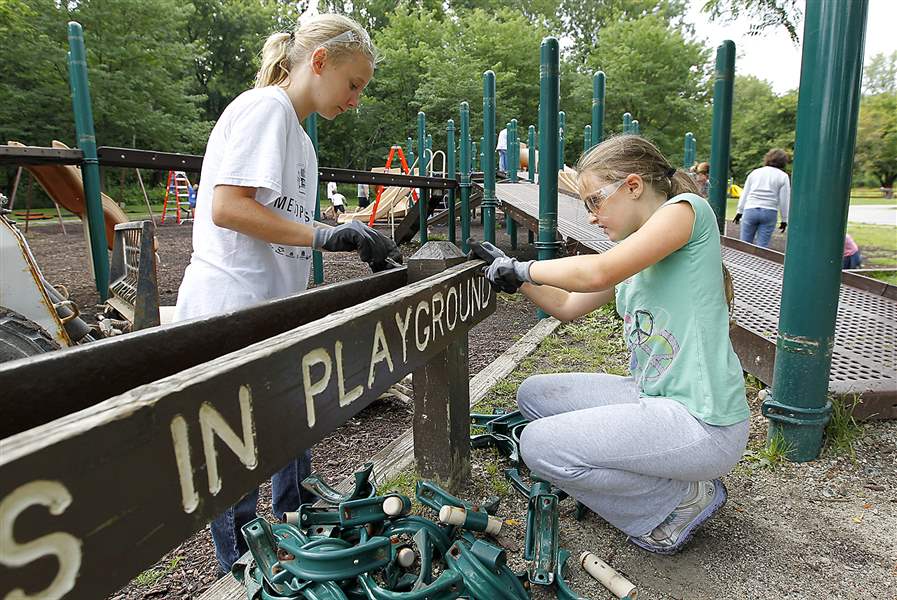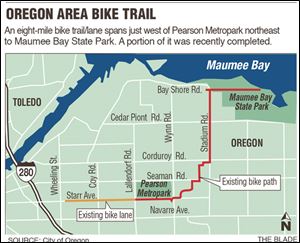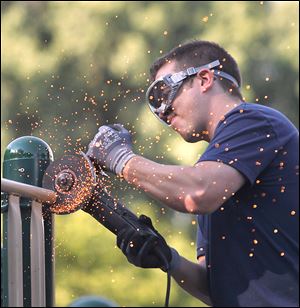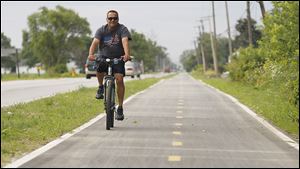
Volunteers clear Pearson Metropark playground
Project for larger replacement targets fall completion
8/6/2013
Samantha Hirsch, 11, and her sister Sydney Hirsch, 8, dismantle a playground sign at Pearson Metropark in Oregon. The 11,000-square-foot area will be the site of a larger playscape in the fall.
THE BLADE/LORI KING
Buy This Image

Samantha Hirsch, 11, and her sister Sydney Hirsch, 8, dismantle a playground sign at Pearson Metropark in Oregon. The 11,000-square-foot area will be the site of a larger playscape in the fall.
Orange sparks whizzed through the air as James Giesken, 46, sawed off a side railing. His son Adam, 10, picked away at a pole, screws popping off as the smell of burning metal filled the sky.
In two days, after slides and swings were stripped away, the Pearson Metropark playground was gone.
Two groups, each with more than 20 BP-Husky Refinery employees and their families, gathered at the metropark recently to dismantle its 15-year-old playground. Their efforts made way for a new playscape area, which will be completed in the fall.
The replacement of the playground is one of many recent changes involving Pearson Metropark, which is connected to Maumee Bay State Park via the Oregon Parks Bike Trail.
The city of Oregon held a ribbon-cutting ceremony late last month to open the newly completed trail, an eight-mile stretch of asphalt that extends from the intersection of Wheeling Street and Starr Avenue to Maumee Bay State Park at Bayshore Road.
Three days later, Pearson Metropark saw the demolition of its old playground. The 11,000-square-foot area will be the site of a larger playscape, one of many “signature playgrounds” planned for the park system.
“Each of these new playgrounds has elements of nature in them,” said Metroparks deputy director Dave Zenk. “[The playgrounds] are creating fun play environments, but are also educational tools that encourage kids to explore nature.”

Pearson Metropark incorporates marsh-themed flora and fauna in its new playground design. Concepts include a bullfrog, large lily pads, and a spinning lotus flower. A mechanized woodpecker will peck at a large hollow tree, which will serve as the centerpiece of the play area.
“We live farther from [Pearson Metropark], but we’ll come here because of the new playground,” said BP-affiliated volunteer Samantha Hirsch, 11, of Sylvania. “The plans look amazing.”
The playground will cost about $300,000 to build, Metroparks spokesman Scott Carpenter said, and is mostly financed by the capital improvements fund for the Metroparks of the Toledo Area. The park system received $50,000 in donations from the BP-Husky Refinery, in addition to a combined $25,000 from the France Stone Foundation, Friends of Pearson, and the Eastern Maumee Bay Chamber of Commerce.
Lucas County voters approved a 0.9-mill levy last November supporting the Metroparks. The property tax, which will be implemented for the next 10 years, costs the owner of a $100,000 home $27.56 a year.
Park officials opened the first signature playground in June at Farnsworth Metropark in Waterville. The playscape, which follows a riverside theme, features sculptures of tree trunks, a great blue heron, and an amiable turtle statue.
The $315,000 construction of a Black Swamp-era farm structure began this spring on the Pearson North expansion and should be completed in the fall, Mr. Carpenter said.

BP-Husky worker Dave Simons saws off a steel railing from the playground at Pearson Metropark in Oregon.
The Metroparks also will concentrate on linking parks and schools with pedestrian-friendly trails. The park system maintains the Wabash Cannonball Trail, the University/Parks Trail, and the Towpath Trail, which snake 35 miles through Lucas County, Mr. Zenk said.
“Our agency will focus on how to stitch all of the assets in the community together like strings on a pearl [necklace] — park to park, parks to community — and will perpetuate these connections,” he added.
Pearson Metropark acquired a section of the Oregon Parks Bike Trail and made it available to the city of Oregon, Mr. Carpenter said.
The path is part of the city’s 2035 Master Bikeway Plan, which strives to create a network of trails from Maumee Bay State Park to the Maumee River.
Costing a total of $1.8 million, the finished trail took more than 15 years to complete. The Ohio Department of Transportation contributed about $1.46 million from the Federal Highway Administration, funding 80 percent, said Paul Roman, director of the city’s public service department. The city of Oregon provided the remaining 20 percent, contributing $360,000, Oregon Mayor Michael Seferian said.
City officials may expand the bicycle trail from Pickle Road to Seaman Road along a Toledo Edison power line, according to city administrator Michael Beazley. Oregon will seek funding for the project in 2014, he added.
Metroparks officials have plans of their own for the future. Additional signature playgrounds will eventually replace aging play structures at Swan Creek Preserve in South Toledo, Side Cut in Maumee, and Wildwood Preserve in Sylvania Township, Mr. Carpenter said.

Oregon resident Alfonso Ummel rides along the recently completed Oregon Parks Bike Trail, which connects Pearson Metropark and Maumee Bay State Park.
More Metroparks are planned for downtown Toledo’s Middlegrounds property, which may open in 2015, and Howard Farms in Jerusalem Township, which may open in 2017 after the site’s natural marshes are restored. Park officials also plan to transform properties on Keil Farm, Fallen Timbers Battlefield, and the Blue Creek Conservation Area into full-fledged parks.
“We are celebrating a diversity of ecosystems across northwest Ohio,” Mr. Zenk said. “There are very few places where you can stand in a moving sand dune and a coastal marshland as you move across the county, and interface with these habitats.”
Contact Rosa Nguyen at: 419-724-6018 or rnguyen@theblade.com.